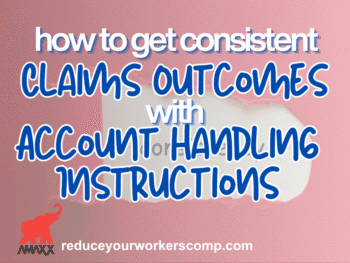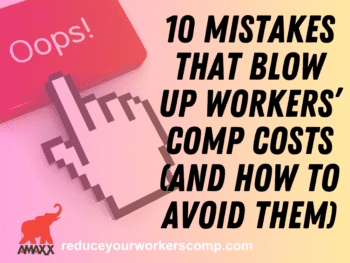
3 Prong Approach to Work Comp Cost Control
We recommend a three-prong approach to employer Best Practices in workers’ compensation cost control. These are the three areas. While there are many best practices, these three are critical – and basic.
- Safety
- Quick Response to Injuries
- Managing the Claim
Click Link to Access Free PDF Download
Safety
The number one way to reduce the cost of workers’ compensation is to eliminate claims. The cost of a comprehensive safety program is only a small fraction of the cost of needless employee injuries. An employer who incorporates safety into the corporate culture will significantly reduce both the severity of injuries and the frequency of injuries.
The reduction in severity and frequency of injuries impacts both the direct and indirect cost of workers’ compensation. Not only are the workers’ compensation premiums and assessments reduced, but the indirect cost of lost productivity and retraining of replacement employees is also diminished.
Every department within the company should have at least one representative on the Safety Committee. This creates a level of involvement for all departments and facilitates the assignment of roles and responsibilities on the safety committee. By having designated duties on the Safety Committee, the employer creates accountability and a safety discipline.
The safety committee members should be made responsible for completing a regular and thorough workplace assessment to identify potential hazards. The management at the employer is responsible for taking prompt action to remove or eliminate the potential hazard.
Quick Response to Injuries
A strong Safety Program will reduce the number of injuries but it will not bring about the total elimination of injuries. When accidents do occur, a quick and well-organized approach to the accident is essential. The actions of the employer in the minutes after an injury occurs can have a major impact on the overall outcome of the claim.
Each person involved in the accident response should have a set of pre-designated responsibilities. The employee, the employee’s supervisor, any witnesses, and the workers’ compensation coordinator should know the established procedures to follow in the event of the injury.
If on-site medical care is not available, the supervisor should immediately accompany the injured employee to the pre-selected medical provider. The supervisor should provide the medical provider with a copy of the employee’s job description and responsibilities, including the physical requirements of the job, and a copy of the Work Ability Form.
FREE DOWNLOAD: “Step-By-Step Process To Master Workers’ Comp In 90 Days”
Managing the Claim
The workers’ compensation coordinator should immediately report the claim to the claims office. The workers’ comp coordinator should gather the employee’s statement of injury, the witness report form(s), the supervisor’s statement of injury, and the completed Work Ability Form from the medical provider’s office. All the documentation should be provided to the claims office. If the injury warrants, the workers’ comp coordinator should contact the adjuster handling the claim to discuss and plan the course of action.
Don’t leave questions on the First Report of Injury blank — append additional information as needed. When the EMPLOYER leaves blank spaces on the FROI, the EMPLOYEE (and his/her attorney) has the opportunity to fill it in…and you can bet their additional information will not be helpful to the employer.
The workers’ comp coordinator should contact the employee within 24 hours of the injury to express the employer’s concern for the welfare of the employee. The coordinator should inquire about the nature and extent of the injury and the diagnosis and prognosis provided by the medical provider. If the employee is unable to return to work on either full duty or modified duty, the coordinator should follow up with the employee after each medical visit to ascertain the status.
If the employee is remaining off work, the employer should provide the medical provider with sample transitional duty job descriptions that can be offered to the employee. By making it easier for the medical provider to return the employee to light-duty work, you will shorten the length of time the employee is off work and reduce the probability of any permanent partial disability.
Safety, quick response to injuries, and claims management are part of the Best Practices for employers.
 Author Michael Stack, CEO Amaxx LLC. He is an expert in workers’ compensation cost containment systems and helps employers reduce their workers’ comp costs by 20% to 50%. He works as a consultant to large and mid-market clients, is a co-author of Your Ultimate Guide To Mastering Workers Comp Costs, a comprehensive step-by-step manual of cost containment strategies based on hands-on field experience, and is the founder & lead trainer of Amaxx Workers’ Comp Training Center, which offers the Certified Master of Workers’ Compensation national designation.
Author Michael Stack, CEO Amaxx LLC. He is an expert in workers’ compensation cost containment systems and helps employers reduce their workers’ comp costs by 20% to 50%. He works as a consultant to large and mid-market clients, is a co-author of Your Ultimate Guide To Mastering Workers Comp Costs, a comprehensive step-by-step manual of cost containment strategies based on hands-on field experience, and is the founder & lead trainer of Amaxx Workers’ Comp Training Center, which offers the Certified Master of Workers’ Compensation national designation.
Contact: mstack@reduceyourworkerscomp.com.
Workers’ Comp Roundup Blog: https://blog.reduceyourworkerscomp.com/
©2021 Amaxx LLC. All rights reserved under International Copyright Law.
Do not use this information without independent verification. All state laws vary. You should consult with your insurance broker, attorney, or qualified professional.
FREE DOWNLOAD: “Step-By-Step Process To Master Workers’ Comp In 90 Days”














